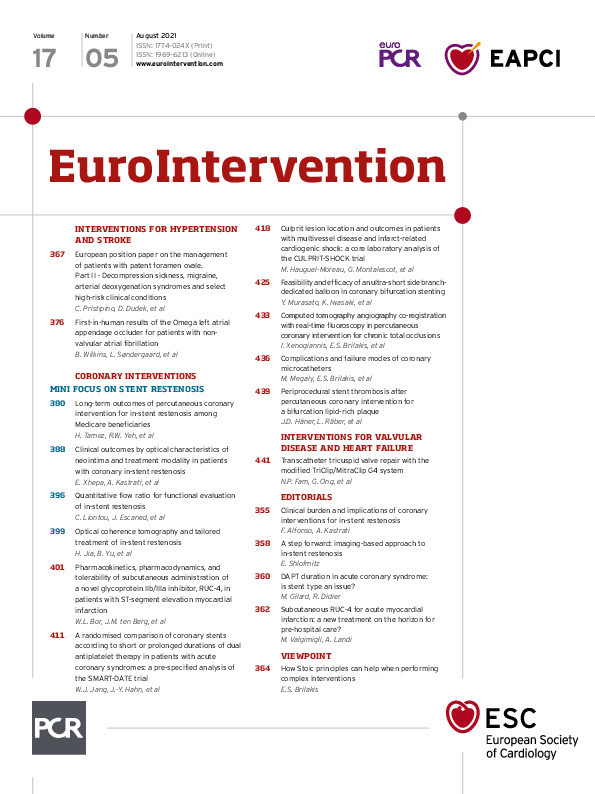After numerous large randomised trials, it is now broadly admitted by the entire cardiology community that at least 12 months’ dual antiplatelet therapy (DAPT) with a P2Y12 receptor inhibitor in combination with aspirin is recommended in patients with acute coronary syndromes (ACS) managed by coronary stent implantation, except in case of a high risk of bleeding1. The ultimate goal of longer rather than shorter DAPT is to prevent thrombus formation in future plaque rupture in patients with a history of ACS, who are at greater risk of ischaemic events than those without, mostly due to plaque destabilisation2. In ACS patients, in addition to the culprit lesion, there may be other unstable lesions. Placing a stent over the culprit lesion does not “passivate” the others. In other words, one-year DAPT makes it possible to treat not only the stent but also the patient, with the aim of reducing the overall risk of ischaemic events.
The SMART-DATE trial (The Smart Angioplasty Research Team: Safety of 6-month duration of Dual Antiplatelet Therapy after Percutaneous Coronary Intervention in Patients with Acute Coronary Syndromes) conducted by J.Y. Hahn and colleagues reinforced the concept of one-year DAPT duration as default strategy after ACS3. Results in 2,712 patients showed that 6-month DAPT was non-inferior to 12-month DAPT on a composite primary endpoint (all-cause mortality, myocardial infarction and stroke) at 18 months after stenting; however, the specific rate of myocardial infarction was higher with 6-month versus 12-month DAPT (1.8% vs 0.8%, p=0.02). The present pre-specified analysis of the SMART-DATE trial4 conducted by W.J. Jang and colleagues compared types of stent (biodegradable polymer biolimus-eluting stent [BP-BES] vs durable polymer everolimus-eluting [DP-EES] or zotarolimus-eluting stent [DP-ZES]), with 1:1:1 randomisation in ACS patients, according to 6-month or 12-month DAPT.
At 18 months, the primary composite endpoint (cardiac death, myocardial infarction, or stent thrombosis) did not differ among the three types of stent (2.6% with BP-BES, 2.0% with DP-EES, and 2.1% with DP-ZES). The comparison among types of stent with BP-BES as reference was similar (HR 1.29, 95% CI: 0.70-2.39, p=0.42 for BP-BES vs DP-EES, and HR 1.23, 95% CI: 0.67-2.26, p=0.50 for BP-BES vs DP-ZES). Also, 6-month DAPT was not associated with a greater risk of device-specific events than 12-month DAPT. In the setting of stent thrombosis, no difference was found among the types of stent, regardless of DAPT duration.
The present study is not directly applicable to a European population, since it was conducted in an East Asian population, which might show different thrombotic and haemorrhagic risks. Also, around 80% of the ACS patients were treated with clopidogrel as second antiplatelet therapy. However, no negative signs were found regarding the use of biodegradable polymer biolimus-eluting stents as compared to durable polymer stents. Concerning stent thrombosis at 18 months, the rate was around 1%, notwithstanding these being new generations of stent. This may have been due to lack of statistical power or, more likely, to the absence of any strong relationship between the type of stent and the occurrence of clinical events in the setting of ACS. In fact, vulnerable lesions could thrombose when antiplatelet therapy is discontinued. Extending the duration of dual antiplatelet therapy may prevent thrombosis of these lesions. The stent is a bystander in ACS but not necessarily “innocent”. With regard to antiplatelet therapy, the clinical situation seems to predominate over the nature of the DES. In ACS, the patient-related risk prevails. Thus, DAPT duration appears to be the primary factor to be taken into account in the management of these patients5.
Nevertheless, DAPT intensity and duration in ACS should be tailored to the individual patient after carefully balancing the risks of ischaemic versus bleeding events, rather than to the new generation DES type.
Conflict of interest statement
The authors have no conflicts of interest to declare.
Supplementary data
To read the full content of this article, please download the PDF.

